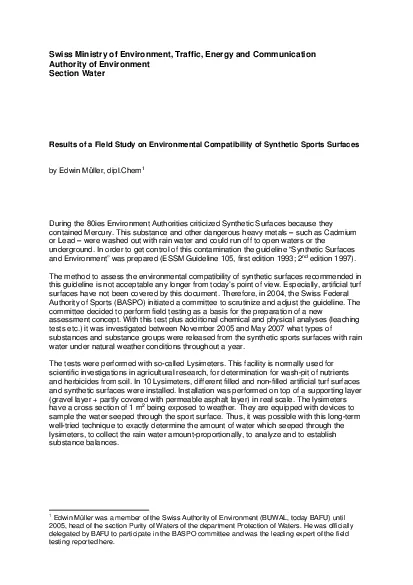

Edwin Mller was a member of the Swiss Authority of Environment BUWAL today BAFU until 2005 head of the section Purity of Waters of the department Protection of Waters He was officially delegated by B ID: 857493
Download Pdf The PPT/PDF document "Swiss Ministry of Environment Traffic En..." is the property of its rightful owner. Permission is granted to download and print the materials on this web site for personal, non-commercial use only, and to display it on your personal computer provided you do not modify the materials and that you retain all copyright notices contained in the materials. By downloading content from our website, you accept the terms of this agreement.
1 Swiss Ministry of Environment, Traffic,
Swiss Ministry of Environment, Traffic, Energy and Communication Authority of Environment Results of a Field Study on Environmental Compatibility of Synthetic Sports Surfaces by Edwin Müller, dipl.ChemDuring the 80ies Environment Authorities criticized Synthetic Surfaces because they contained Mercury. This substance and other dangerous heavy metals such as Cadmium or Lead were washed out with rain water and could run off to open waters or the underground. In order to get control of this contamination the guideline Synthetic Surfaces and Environment was prepared (ESSM Guideline 105, first edition 1993; 2 edition 1997). The method to assess the environmental compatibility of synthetic surfaces recommended in this guideline is not acceptable any longer from todays point of view. Especially, artificial turf surfaces have not been covered by this document. Therefore, in 2004, the Swiss Federal Authority of Sports (BASPO) initiated a committee to scrutinize and adjust the guideline. The committee decided to perform field testing as a basis for the preparation of a new assessment concept. With this test plus additional chemical and physical analyses (leaching tests etc.) it w
2 as investigated between November 2005 an
as investigated between November 2005 and May 2007 what types of substances and substance groups were released from the synthetic sports surfaces with rain water under natural weather conditions throughout a year. The tests were performed with so-called Lysimeters. This facility is normally used for scientific investigations in agricultural research, for determination for wash-pit of nutrients and herbicides from soil. In 10 Lysimeters, different filled and non-filled artificial turf surfaces and synthetic surfaces were installed. Installation was performed on top of a supporting layer (gravel layer + partly covered with permeable asphalt layer) in real scale. The lysimeters have a cross section of 1 msample the water seeped through the sport surface. Thus, it was possible with this long-term well-tried technique to exactly determine the amount of water which seeped through the lysimeters, to collect the rain water amount-proportionally, to analyze and to establish substance balances. Edwin Müller was a member of the Swiss Authority of Environment (BUWAL, today BAFU) until 2005, head of the section Purity of Waters of the depart
3 ment Protection of Waters. He was offici
ment Protection of Waters. He was officially delegated by BAFU to participate in the BASPO commtesting reported here. The following surface systems have been installed and investigated. Artificial Turf - Artificial turf filled with EPDM granules (peroxide cured) and quartz sand on top of an elastic layer - Artificial turf filled with truck tire granules and quartz sand - Artificial turf filled with EPDM granules (sulfur cured) and quartz sand on top of an elastic layer - Artificial turf without in-fill Synthetic Surfaces - water permeable EPDM surface - water permeable surface with spray - impermeable sandwich surface Reference Installations - gravel layer without any cover - gravel layer with asphalt drain layer - elastic layer of SBR granules bound The analytic measurements of the water coindividual substances which are used in formulation of rubber or substances which can be produced of the various rubber chemicals as a transformation or decomposition during the curing process. The variety of these substances is large. Therefore, a selection had to be Sum parameters individual substances - DOC (diluted organic carbon) - Sum of the solved organic nitrogen - alkylated Phen
4 ylendiamine - benzothiazol - cyclohexami
ylendiamine - benzothiazol - cyclohexamin - 16 polycyclic aromatic hydrocarbons - ammonimum nitrogen - nitrate nitrogen - nitrit nitrogen In addition to the lysimeter field tests, the zinc content of the various rubber granule products were determined and Differential Scanning Thermo Analyses as well as leaching tests were performed for characterization of the products. The field tests have shown that the todays micro analytic technique enable to detect even the least traces of organic substances in the water drained from synthetic sports areas. These substances are washed off the surface of the granules by rainwater within a relatively short time. At the end of the 1-year test period the concentrations of the analyzed substances were below the analytic determination limit of 0.2 µg/liter water. This behavior could also be found with leaching tests (i.e. several hour shaking of the granules). The found substances are the same trace substances which are contained in road drainage waters (as a consequence of tire abrasion) and in purified waste water of municipal purification plants. During the whole test period no enlarged amounts of zinc were released to the aquatic environmen